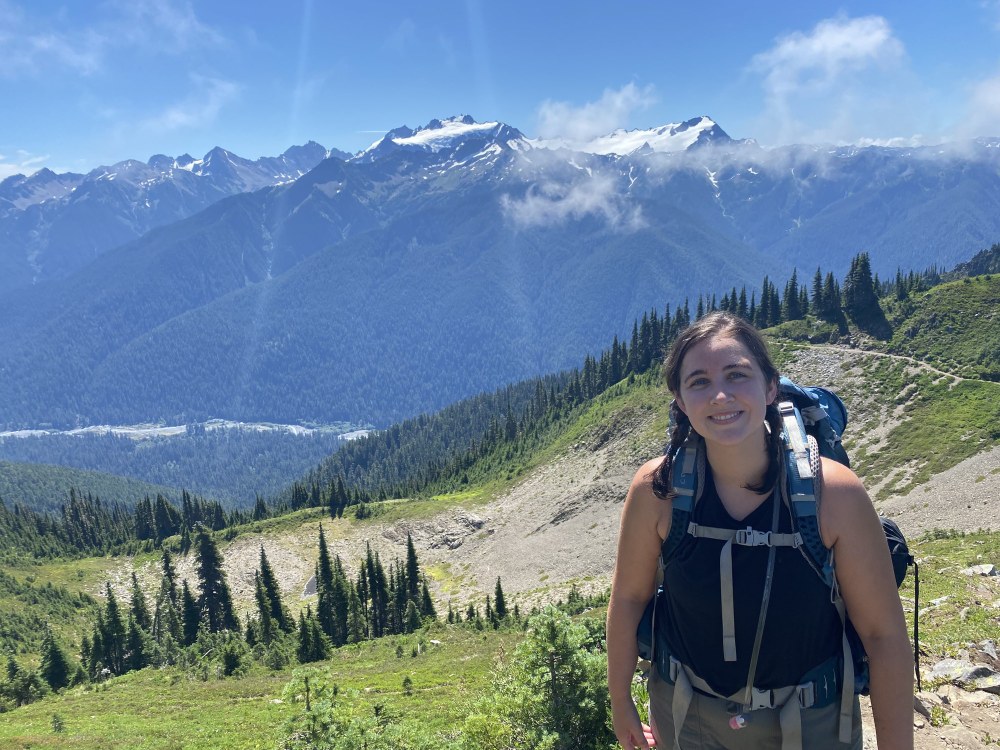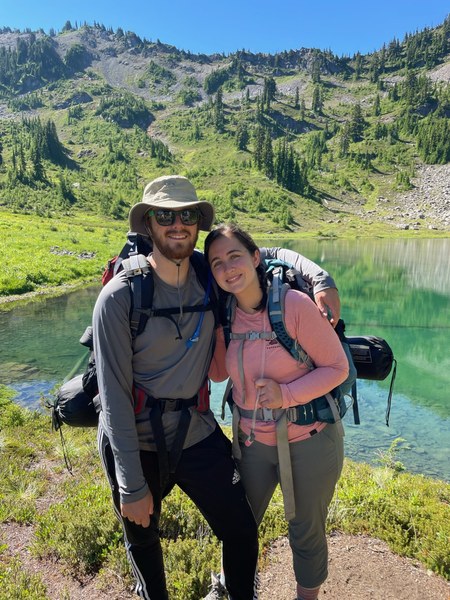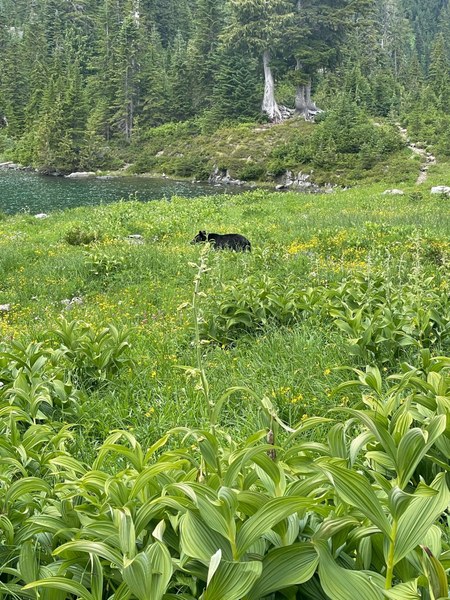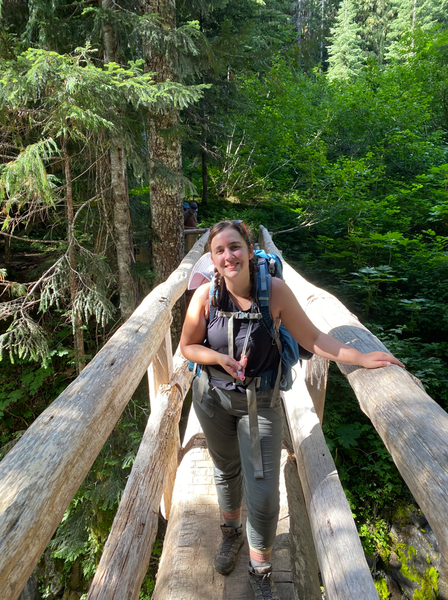
As a San Francisco-born and raised city girl, I used to dread backpacking. My love of the outdoors inspired me to move to the Pacific Northwest in 2016, but backpacking remained a beast I feared to tackle.
After having car camped and day hiked for three years, backpacking began to pique my interest. I wanted to explore the more untouched Pacific Northwest wilderness and step outside my comfort zone. So, last summer, I gathered the Ten Essentials and embarked on my first backpacking trip: Seven Lakes Basin in Olympic National Park.
Preparing for the trail
To prepare for my expedition, I closely studied the trail. Seven Lakes Basin clocks in at roughly 20 miles — depending on how much you explore around the lakes — and includes about 5,120 feet of elevation gain. I knew that the elevation would be the hardest part for me, so I started training six months before my trip and made elevation acclimation my top priority.
My backpacking partner and I intended to cover over 3,000 feet of elevation in only six miles during the first day. To practice and build strength, I set my sights on day hikes that had comparable elevation gains. My training location of choice was Mt. Si, just outside of North Bend. Its climbs were even steeper than the trail I would be doing for my trip, and I figured that training somewhere more difficult would boost my confidence.
 Dominique and her partner on day two of their backpacking trip.
Dominique and her partner on day two of their backpacking trip.
To practice carrying a heavy backpack uphill, I filled my day-hiking pack with extra weight by using gallon jugs of water. If I found myself too exhausted on a training hike, I could lighten my pack by dumping out some water and finishing the trail. As time went on, I gradually increased the amount of water until I reached my desired pack weight.
Persevering through defeat
My first training session was not a success.
Mt. Si begins with an immediate uphill climb and endless switchbacks. I was carrying around 20 pounds in my pack — something I had never tried before — and couldn’t make it to the end of the trail. After about two hours of non-stop elevation gain, I collapsed on a nearby bench. My legs were shaking and I was completely out of energy. About halfway up, I turned around.
This first failure left me deflated. I was consumed with the anxiety that I wouldn’t be able to build the conditioning to complete my backpacking trip. As I drove home, fears swarmed my mind. I could see myself attempting the Seven Lakes Basin and giving up before the finish line. I continued to train, but the fear of being defeated by the trail stuck with me.
My second attempt was unsuccessful, too. Halfway through, I released some weight out of my bag in an attempt to reach the summit. But even then, my feet hurt with every step. I stopped frequently to catch my breath, and my shoulders ached under the weight of my pack. I turned around before reaching the top.
On my third attempt at Mt. Si, I finally summited. As I hiked uphill, I felt the usual pains in my feet and shoulders, but my outlook was different. I had attempted the trail twice at this point, so I knew what to expect. I took breaks frequently, drank plenty of water, and kept my pace slow and even. As I stood at the top of Mt. Si and looked at the valley below, I felt for the first time that I had a chance of actually completing a backpacking trip.
 A black bear grazing on wildflowers near the campsite.
A black bear grazing on wildflowers near the campsite.
Gathering gear and beta
I kept hiking Mt. Si, adding slightly more weight each time, until I got to 40 pounds. I knew this was more weight than I would need, but it helped my confidence grow. I wanted to push myself and shake off the lingering fear of not being able to reach my goal.
There were others fears, too, that clouded my mind. I worried about animals, inclement weather, and unforeseen dangers that might cross my path. To tackle this fear, I studied the trail extensively and sought out stories from other backpackers who had recently completed Seven Lakes Basin. I noted their suggestions about the trail conditions, weather, and wildlife they saw along their journey. I wanted to avoid any unwanted surprises.
Next came the gear. I had acquired all of it, but wanted to make sure I knew how to use everything correctly, so I started bringing my backpacking gear on weekend car camping trips. The equipment required for backpacking can be overwhelming, and adding additional gear to an already packed camping car can be challenging. Still, I found it incredibly useful to familiarize myself with my equipment.
Getting acquainted with my bag helped a lot. I learned how to pack and adjust the straps to distribute the weight and organize the contents to easily access food, clothes, and water. I also practiced deflating and repacking my sleeping pad, which resisted but eventually fit back in its sack. The sleeping pad provided much more insulation than I anticipated, so I learned to avoid overheating at night by layering appropriately. This ultimately saved me pack space.
Putting training into action
On the morning we left for Seven Lakes Basin, I woke up early to make breakfast and ensure I had everything I needed. I was eager to prove I could complete this hike, and worried about what would happen if I couldn’t. I started the trail feeling nervous.
The trail started flat, but quickly steepened into switchbacks under heavy forests. The climb felt strenuous at first. My pack weighed on my shoulders as my feet slowly acclimated to the steady incline. I kept my head down and focused on maintaining a steady pace. But shortly after the second mile, the tension in my body faded. The beauty of my surroundings distracted me from the difficulty of the climb.
Before I knew it we were on the ridgeline, staring down at the valley we had started climbing only a few hours earlier. Vibrant wildflowers covered the trail. Snow-dusted peaks and hidden glaciers sparkled in front of us. In the valley below we could spot lakes, meadows, and even the occasional black-tailed deer grazing. I even opted to take a detour, adding a few extra hundred feet of elevation gain. When we reached the ridge’s highest peak, we were greeted by views of Mt. Olympus, which dominated the sky line. Its peaks were covered in thick beds of snow. To the left, Blue Glacier curved down the mountain like a pathway that perfectly reflected the clear-blue sky. Although exhausted, I felt energized by the surrounding landscape. The pictures I had seen on trip reports couldn’t compare to the first-hand experience, and the fears I had throughout my training dissipated.
As we descended the ridge to our campsite, we saw several black spots throughout the meadow below, and as we got closer, we realized these spots were black bears. The old me of only a few months earlier would have been terrified. But thanks to my research, I knew black bears were extremely common in this area, and I was equipped with appropriate knowledge. I knew we could handle the situation safely by traveling in a group — which we were doing — carrying bear spray, and making soft noises to let the bears know of our presence. Armed with these safety tips, I enjoyed watching the bears from a respectful distance as they ate flowers and dipped in the water.
 Dominique crossing a bridge before the initial climb.
Dominique crossing a bridge before the initial climb.
Cultivating confidence through new experiences
We traversed 11 more miles the next day, despite aching feet and sore muscles. The last third of the trail wandered through old forest growth so thick we could no longer see the sky. We wove our way between flowing creeks and ancient trees covered in moss. I won’t lie, I was pretty beat, but I was filled with so much pride that I had made it this far.
I had spent months fearing that I would be underprepared or unable to finish the hike. Yet there I was: sore, but confidently taking one step after another. At the last mile, I turned to my partner and bet him I could beat him to the finish line — and I did.
By backpacking the Seven Lakes Basin, I plunged into the unknown and came away with a sense of confidence. I allowed myself to be a beginner and accepted failure until I persevered. This kind of acceptance comes fairly naturally to children. But as adults, this growth mindset can be a harder lesson to learn. It's challenging to fail at something, and even harder to pick yourself back up and try again. But now that I have succeeded at backpacking, my mind feels free to wonder what else I can achieve. I’m looking at snowboarding and rock climbing next, but this time around, I’ll be taking the learning curve with a smile and the initial failures with a hearty laugh.
Dominique’s tips for tackling your first backpacking trip
- Identify your areas of improvement and train accordingly. These areas could be conditioning for elevation gain, getting accustomed to heavier pack weight, or learning how to use your gear appropriately.
- Set reasonable goals. Don’t try to accomplish too much on your first trip. If you are new to backpacking, start with a single night backpacking trip that covers fewer than five miles each way and less than 1,000 feet of elevation gain.
- Study your route. Know how much elevation you will be covering within a given mileage, where your water sources are, what wildlife you may encounter, and what the trail conditions are like. The Mountaineers has great trail details on their Routes & Places webpage, as well as recent trip reports completed by hikers.
- Research gear and use it before your trip. If it’s adding weight to your pack, you should know how to use it. And don’t forget, there’s no shame in practicing how to pitch a tent in your backyard.
- Don’t be afraid to mess up. It's all part of the process. Messing up is how you learn what works for you and what doesn’t.
- Lean on your community for advice and support. It can be hard to ask for help, but that’s what your Mountaineers community is there for, and they are learning from experience just like you.
- Have fun and immerse yourself in nature. This is the primary goal of backpacking — don’t lose sight of the wonder and excitement of the outdoors! Not everyone gets to climb 3,000 feet to a gorgeous overlook, watch bears and elk forage in their habitats, or walk a path among mountain wildflowers.
This article originally appeared in our summer 2023 issue of Mountaineer magazine. To view the original article in magazine form and read more stories from our publication, visit our magazine archive.
 Dominique Sabins
Dominique Sabins